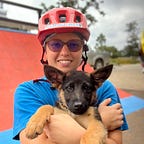Part 2_Animation Planning
Illustrated Animations for Virtual Reality_Using Adobe After Effects & Autodesk Sketchbook
Illustration Planning
So for this project we have 3 layers — throughout this blog we will discuss how we are going to plan the illustration in such a way to ensure, not only that animation in After Effects can go smoothly, but also and maybe even more importantly, that the illustrations can be done in minimal time with maximum quality and utility precision when it comes to working on the different layers of the PSD file to create the animations in After Effects.
For this we will be planning every layer according to what animation work we want done with each drawing.
Only after all this planning is done, can we commit to refine the final drawings.
Step 1) Plan basic environment movement ‘population’
For example in this scene we have this as our motion script:
- A doctor is busy sawing a patient’s leg off.
- The patient screams.
- Helpers aggressively pin down the writhing patient.
This means that we would very specifically need separate manipulable layers for —
- The sawing action from the dr’s side = layer for dr’s arm + layer for saw + layer for dr’s eyes/ mouth, maybe frown, maybe an extra hand on the opposite side as the sawing arm
- The patient’s writhing and screaming = layer for amputated limb + layer for patient’s mouth + layer for patient’s eyes
- The helper’s aggressive ‘pinning down’ action = layer for each helper
Step 2) Decide on animation technique to use for which objects
The most important elements’ animations will be done using this type of technique:
However if this is too much effort in the long run, which it might be thinking about the cost efficiency, we can simply use the above method for only the most important elements that need animation and then we can do the “duplication with minimal illustrated changes effect” on the second wave priority items and animate them like this —
Summary
So when we sync the focus of the scene and the animation method, we are able to get more of an idea of how much time will be spent implementing the above methods — aka animating the still illustrations.
From this breakdown we have also learnt that we can easily plan the separate elements that need to be illustrated and how these drawing will be refined by means of very particularly choosing which motions to focus on and using the layer options in Sketchbook parallel to the layer requirements laid out within each illustration element’s ‘script’.
See here for the next blog in this series “Part 2_Follow Up Blog_Animation Planning”.
See here for the full list of blogs in this series:
Illustrated Animations for Virtual Reality using Adobe After Effects & Autodesk Sketchbook
-Intro — Illustrated Animations for Virtual Reality
-Project Phase_Workflow planning:
